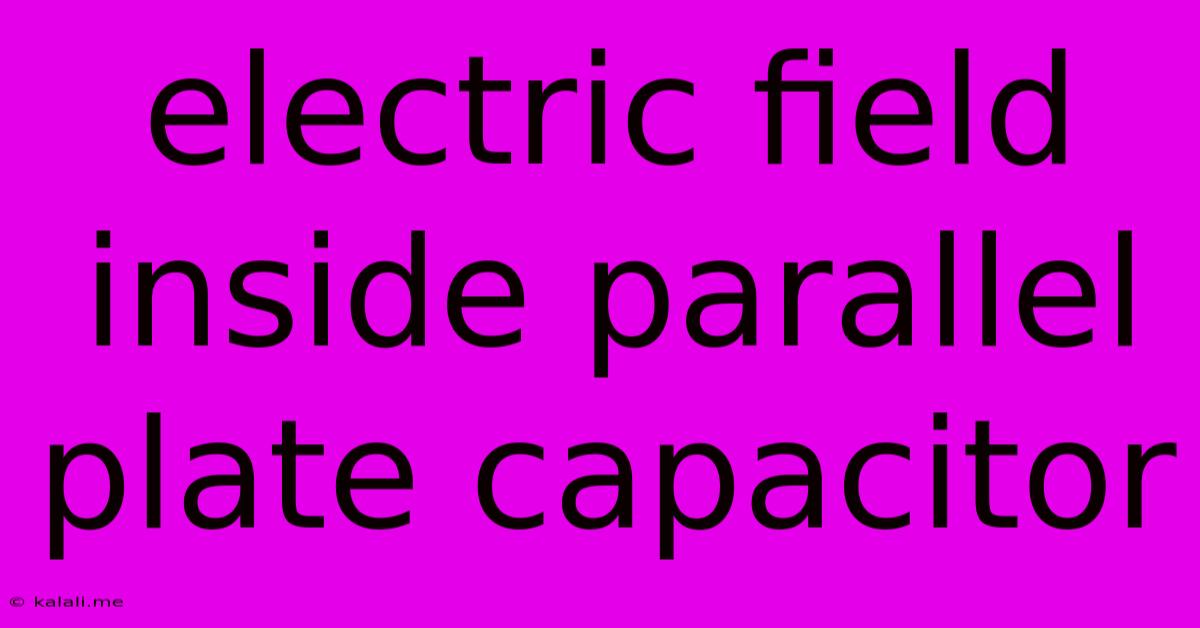Electric Field Inside Parallel Plate Capacitor
Kalali
Jun 03, 2025 · 3 min read

Table of Contents
Understanding the Electric Field Inside a Parallel Plate Capacitor
The parallel plate capacitor is a fundamental component in electronics, and understanding the electric field within it is crucial for grasping its operation. This article delves into the intricacies of the electric field within this device, explaining its uniformity, its dependence on charge and distance, and some key considerations for real-world applications. This exploration will cover both the idealized scenario and the practical realities.
What is a Parallel Plate Capacitor?
A parallel plate capacitor consists of two conductive plates, typically metallic, placed parallel to each other and separated by a small distance. This space between the plates is usually filled with a dielectric material, an insulator like air, plastic, or ceramic, which influences the capacitor's capacitance. When a voltage is applied across the plates, one plate accumulates a positive charge (+Q) and the other an equal and opposite negative charge (-Q). This charge separation creates an electric field between the plates.
Idealized Electric Field: Uniformity and Strength
In an idealized parallel plate capacitor, assuming the plates are infinitely large and the distance between them is much smaller than their dimensions, the electric field between the plates is remarkably uniform. This means the field strength (E) is constant at every point between the plates, and the field lines run straight and parallel from the positive plate to the negative plate. The strength of this uniform electric field is directly proportional to the surface charge density (σ) on the plates and inversely proportional to the permittivity (ε) of the dielectric material between them:
E = σ / ε = Q / (Aε)
Where:
- E is the electric field strength
- σ is the surface charge density (charge per unit area: Q/A)
- ε is the permittivity of the dielectric material
- Q is the charge on one plate
- A is the area of each plate
This simple equation highlights the key factors influencing the electric field strength: more charge (Q) leads to a stronger field, a larger plate area (A) reduces the field strength, and a higher permittivity dielectric (ε) also weakens the field.
Beyond the Ideal: Edge Effects and Fringing Fields
The idealized model assumes infinite plate dimensions. In reality, the plates are finite, resulting in fringing fields at the edges. These fringing fields are non-uniform and deviate significantly from the uniform field within the central region. The closer to the edges of the plates you get, the less uniform the field becomes. This non-uniformity at the edges is important to consider in high-precision applications.
Dielectric Material Influence
The dielectric material between the plates plays a critical role. It affects not only the strength of the electric field but also the capacitance of the capacitor. A higher permittivity dielectric material allows for a larger amount of charge storage for the same voltage, leading to a higher capacitance. The electric field within the dielectric is reduced compared to a vacuum due to the polarization of the dielectric material.
Applications and Significance
Understanding the electric field inside a parallel plate capacitor is fundamental to numerous applications:
- Capacitance Calculation: The uniform field assumption simplifies the calculation of capacitance, a crucial parameter in circuit design.
- Electrostatic Applications: Uniform fields are vital in applications like electrophotography (copying machines) and ink-jet printers where precise control over charge distribution is crucial.
- High Voltage Applications: Accurate understanding of the field strength is crucial in high-voltage systems to avoid dielectric breakdown.
In conclusion, the electric field inside a parallel plate capacitor is a complex phenomenon with an idealized model of a uniform field. However, practical considerations, such as fringing fields and the influence of the dielectric material, are crucial for a complete understanding and effective application in real-world scenarios. Considering these factors ensures accurate predictions and optimal performance in various electrical and electronic applications.
Latest Posts
Latest Posts
-
Why Dont We Feel Earth Rotation
Jun 05, 2025
-
How Do You Say Crush In Spanish
Jun 05, 2025
-
Why Did Lee Say He Fought
Jun 05, 2025
-
Til Death Do Us Part Meaning
Jun 05, 2025
-
A Cord Of 3 Strands Bible Verse
Jun 05, 2025
Related Post
Thank you for visiting our website which covers about Electric Field Inside Parallel Plate Capacitor . We hope the information provided has been useful to you. Feel free to contact us if you have any questions or need further assistance. See you next time and don't miss to bookmark.